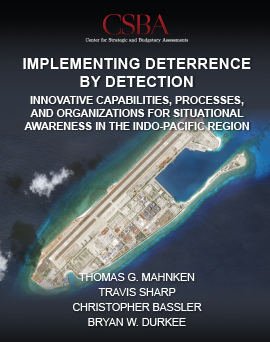
The Center for Strategic and Budgetary Assessments (CSBA) held a webinar on Thursday, July 22, 2021, to discuss its newest report, Implementing Deterrence by Detection: Innovative Capabilities, Processes, and Organizations for Situational Awareness in the Indo-Pacific Region with authors Thomas G. Mahnken, Travis Sharp, Christopher Bassler, and Bryan W. Durkee, as well as CSBA Council member Chris Brose.
One of the essential hallmarks of deterrence is the ability to effectively detect – and therefore prepare for – a potential adversary’s hostile action in a timely fashion. Just as the threat of effective retaliation must be credible, deterrence also depends on a robust ability to identify and assess aggressive acts, including acts of coercion that fall below the threshold of kinetic conflict. Recent Chinese actions toward Taiwan, for example, have heightened the conviction among U.S. and allied defense planners that effective, interoperable intelligence, surveillance, and reconnaissance (ISR) systems are essential for the security of the entire Indo-Pacific theater.
Building upon last year's Deterrence by Detection study, Implementing Deterrence by Detection: Innovative Capabilities, Processes, and Organizations for Situational Awareness in the Indo-Pacific Region assesses how both current platforms and emerging capabilities could be utilized to improve dramatically situational awareness in the Indo-Pacific region. The report focuses on ISR capabilities, processes, and allied engagement in the region. In the report, CSBA President Thomas G. Mahnken, Senior Fellow Christopher Bassler, Fellow Travis Sharp, and Navy Fellow Bryan W. Durkee argue that the United States and its allies should fully leverage existing ISR capabilities by boosting their performance with technology enablers, streamlining processes with Artificial Intelligence and other tools, and improving regional military coordination. Rather than seeking to replace all existing systems with new capabilities, the authors argue for a cost-effective approach that would enhance current technologies and bolster near-term deterrence in the Indo-Pacific region. This framework would also tie existing capabilities to missions outlined in the 2018 National Defense Strategy (NDS) and lays the foundation for next-generation ISR capabilities and processes.



























